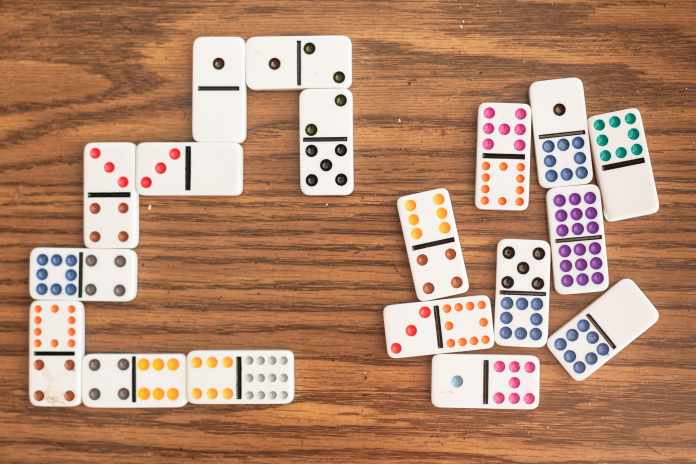Dominoes is a tile-based game that people play with rectangular domino tiles. Each rectangular tile has a line dividing its face into two square ends. Each end has several spots, which people refer to as pips, nips, or dobs. The end can be blank sometimes.
The backs of the dominoes are hard to tell apart. They are either empty or have some standard design. The domino tiles that make up a domino set are a deck or pack.
The traditional Sino-European set consists of 28 dominoes that features all combinations of spot counts between zero and six. A domino set is similar to playing cards or dice, in the sense that people play the games with a pack. We will explain how to play ‘Dominoes’ in this article.
Table of Contents
History of dominoes
Dominoes’ earliest mention comes from the Song dynasty, China, from the texts of Wulin, written by author Zhou Mi (1232–1298). People used many different domino sets in various parts of the world to play multiple domino games for centuries now.
In Italy, modern dominoes first made their appearance during the 18th century. But how did the Chinese dominoes develop into the modern game is still unknown? It’s thought that Italian missionaries in China were the ones to bring the game to Europe. The game changed somewhat while transferring to the European culture. The European domino sets contain neither suit distinctions nor the duplicates that the Chinese dominoes held.
Composition and construction of dominoes
European dominoes are traditional of ivory or bone, or a dark hardwood such as ebony, with contrasting black or white pips, painted or inlaid on them. Throughout time people made dominoes from many materials, like marble, granite, or soapstone. Woods such as ash, oak, cedar, and redwood. Metals such as brass, pewter, etc.
People also use ceramic clay, frosted glass, crystal, etc.,to make dominoes sets. These sets have a novel look and are heavier in weight. The heavyweight makes them feel more substantial. Products made with such materials are usually much more expensive than polymer materials. Modern domino sets use materials such as polystyrene plastics, bakelite, or other phenolic resins. Many dominoes set approximate the ivory sets’ feel and look, while others use translucent or colored plastics to achieve a more contemporary look.
One can find a domino set made of card stock used for playing cards. Such dominoes set are inexpensive, compact, and have a lightweight. They are also susceptible to minor disturbances such as a sudden breeze like cards are. Sometimes, dominoes have a metal pin in the middle, which is a spinner or pivot.
How to play dominoes (The Basics)
If you want to know how to play dominoes, you need to learn the basics. They are;
-
Tiles shuffling
Before every game, a player will shuffle the tiles face down on a flat surface on which the players play the game. By moving the tiles with his hands, the player thoroughly mixes them. While shuffling, the player’s hands may not stay on the same tiles. The player who shuffles the tiles should be the last to draw his hand for the game.
The same player can shuffle the dominoes before each play. Players can also choose and take turns mixing before each game.
-
Seating Arrangement
In domino games, a player’s position at the table in a game with three or more players is a seat.
One way to determine this arrangement is by drawing a lottery. After shuffling the tiles, every player draws a domino tile from the stock. The player who removes the tile with the highest number of pips gets to have the first choice of seats. The player holding the next highest number will sit to the left of the first player, and so on.
If a tie occurs, the players break it by drawing new dominoes from the stock. After determining the players’ positions, the players return the tiles to the stock and then reshuffle them before they pull their hands. If the players play a partnership game, the partners will sit opposite each other.
-
Order of Play
There are several ways to determine which player will make the first play. They are:
-
Drawing Lots or lottery to Determine Who Will Make the First Play
After shuffling the tiles, each player draws a domino from the stock. The player who removes the heaviest tile will make the first play. If a tie occurs, players break the tie by pulling new dominoes that remain in stock.
Setting the Heaviest Domino and beginning the game:
Some domino game rules state that the player who has the highest double in his hand must make the first move. In contrast, others say that the player with the heaviest domino must make the first move, whether single or double.
-
Highest Double:
After shuffling the tiles, each player draws his hand from the stock. The player who can pull the highest double of the set can play it as the lead. If the highest double doesn’t get drawn, the second-highest double is played, and so on. It goes on till one plays a double. If no one holds a double in their hand, all hands discard, reshuffle again, and draw new hands. After setting his double, the player sitting left to the first player makes the second play, and the game continues as a clockwise rotation.
- Heaviest Tile:
In this case, follow the instructions of “Highest Double.” If no one holds a double tile, the player holding the heaviest single will begin the play instead of drawing new hands.
Winner of the Last Game:
The last game-winner may make the first play in the next game. If a tie occurs, the player who placed the last tile in the previous match may make the first play in the next round.
After determining who will make the first play of the game, the seating arrangement will decide the play order. Before the game starts, the players must agree if the play will continue to the left, clockwise, or continue in a counter-clockwise rotation after making the first play.
- Drawing hand
At first, each player will draw the number of tiles specified in the game’s rules. After pulling them, he places them in front of himself so that the other players can’t see the pips on his tiles.
After drawing all hands, some tiles might remain in the stock. These tiles should remain face down. Depending on the game rules, players may bring them later in that game.
-
Opening the Game
Determine who will make the first play, according to the particular domino game’s rules or by the ‘order of play’ mentioned above. The player making the first play will be the leader or the setter.
The words ‘set,’ ‘down,’ and ‘lead’ are all used as verbs to refer to the act of making the first domino played in a game and also the first play of the game.
Here is a rule variation that the players playing the game may agree to take on:
When a player plays a double, whether for the game’s opening or during the game, he can immediately play a second tile onto his double before the player next in the order makes his play.
- Passing and Byeing
Any player who doesn’t hold a tile with the correct number of pips in his hand can’t make the next play. According to the game rules, he must either pass or bye from the stock. Some of the games permit the players to skip a play if they choose so even if they hold a playable tile.
-
Passing:
- Passing is called knocking or renouncing as well. The player who cannot make a play must announce that “I pass.” Then the next player in order will take his turn. If no one can make a play any further, then the game will end.
- Byeing: In this case, according to the rules of the particular game, a player can draw a tile from the stock and add it to the tiles in his hand. After removing a tile, he can play, and he plays that domino. Some games allow byeing the remaining tiles from the stock, while others don’t.
In many domino games, the rules state that the players can bring all tiles that remain in the stock, while some state that some tiles must be left in the stock and players can’t bring them. If the players cannot buy the tiles, the number of pips on the tiles left in the stock increases the winner’s score at the end of the game.
-
Line of Play
Many domino games depend on suit matching. After the first player sets his domino, then the player next to his left adds a tile to one of the free ends, and so on. It goes clockwise around the table. Each player adds a tile. Players add tiles with the matching number of pips with an open end of a tile that they played already.
A line forms when each player matches and plays a tile. This configuration of dominoes is called the string, layout, or line of play. If the line of play extends too far, players can play the tiles in any direction so that the tiles don’t fall off the table. The open end of the last played domino stays the same, regardless of the pattern of the line of play.
In the line of play, players can join dominoes in two ways: lengthwise (the dominoes played end to end) and crosswise (the dominoes played across the matching number.)
Only doubles are played crosswise in most dominoes, and singles are played lengthwise. After playing each double, the player can add the next tile. If the double play is not a spinner, then the player must add the next tile lengthwise.
-
Spinners
If you want to know how to play dominoes, you need to know about spinners.
A spinner is a double. People can play it on all four sides. Depending on the rules of the particular game, either playing the double as the lead will be the only spinner of the game; or, every double that’s played during the game is a spinner.
If the double that’s played doesn’t turn out to be a spinner, it may be played on only two sides.
-
Scoring
You must know about scoring if you want to learn how to play dominoes.
In some domino games, the score obtains from the total number of pips at the ends of the line of play. Both ends of a domino will be counted as ends of the line of play if only one domino gets played. Thus, the count would be ten if a 5-5 tile is played.
In two dominoes play, the count will depend on whether both tiles match the line of play. Or one tile is with the line of play, and the other tile is across the line of play.
For example, if the 3-5 and 5-1 tiles are played, the count will be (3+1)=4. The halves of the two dominoes that match each other would be joined, end to end, with the open ends 3 and 1. The count will be (3+5+5)=13 if the 3-5 and 5-5 tiles are played. Both the halves of the double would be considered ends of the playline and will play the double tile (5-5) across the line of play.
Following the last example,
if a tile is now played on the 5-5, but it doesn’t turn out to be a spinner, then the (5-5) is no longer an end for counting. For example, the playline is 3-5, 5-5, 5-1, and the count is 4 (3+1). If the 5-5 is not a spinner, then the 5-5 is not an end in this case.
In many domino games, a score is made only when the count of the line’s ends is a multiple of 3 or a multiple of 5. In some domino games, scoring is done by counting the pips on the tiles left in the losing player’s hands at the end of the game and then adding that number to the winner’s score.
For example: when you count the pips left in the losers’ hands tiles at the end of a hand or the game, count only one end of a double, like 4-4 counts as only 4 points and add that 4 points to the winner’s score.
-
End of the Game to play dominoes
Some domino games end once a player or team makes the necessary points to win or a certain number of hands have been played.
For other domino games, the game ends when a player has played all the dominoes in his hand before the other players and announces, “Domino.”
Sometimes what happens is that none of the players can make another play. It is a blocked game. In this case, if the game stops and no one can make another play, the game ends.
Different domino games and how to play dominoes game
There are many versions of domino games, played across the world. Some of the famous domino games are:
-
Bidding play dominoes
Bidding games are just like card games. Two to four players play it. At the start of this game, the players bid their hands and the player with the highest bid names the suit. In this game, the bid determines the score.
-
Blocking play dominoes
It is the most basic domino games that are out there. Two players play the game. Each player requires a double-six set. At the beginning of the game, the 28 tiles are shuffled face down and form the stock. Then both players draw seven tiles from the stock. The tiles are placed on-edge in front of the players so that each player can see the value of their tiles, but they can’t see the value of the tiles of other players’.
One player begins the game by playing the first tile. This tile starts the line of play, and values of adjacent pairs of tile ends must match in it. Then the players extend the line of play alternately with one tile at one of its two ends. If a player cannot place a suitable tile, he must continue to draw tiles from the stock until he can put a tile.
The game will end when a player wins by playing his last tile. The game also ends when blocked because none of the players can play. If that happens, the player who caused the block receives all of the other player’s remaining points, not counting his own.
-
Scoring play dominoes
In this game, players build up points during gameplay for emptying one’s hand or for specific configurations and moves. Most scoring games use the techniques used in the draw game.
If a player doesn’t call “domino” before laying the tile on the table, and another player says domino after laying the tile, the first player has to pick up an extra domino.
-
Draw game play dominoes
In a draw game, players can draw as many tiles as they desire from the stock before playing a tile. But they aren’t allowed to pass before the stock gets nearly empty.
The number of pips in the hand of the losing player’s plus the number of pips in the stock is considered the game’s score. Most rules state that two tiles should remain in the stock.
We hope this article’s information helped you to learn how to play dominoes.








